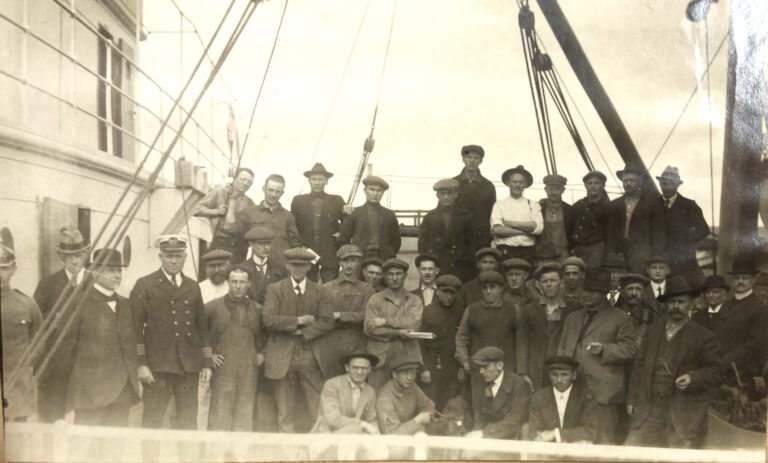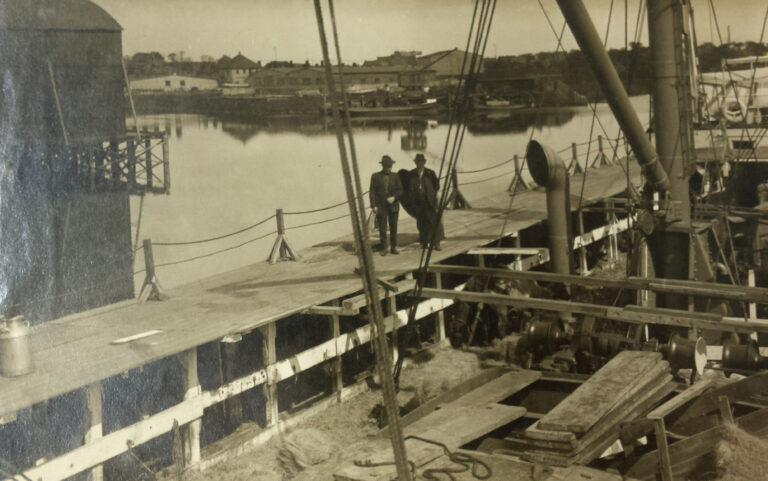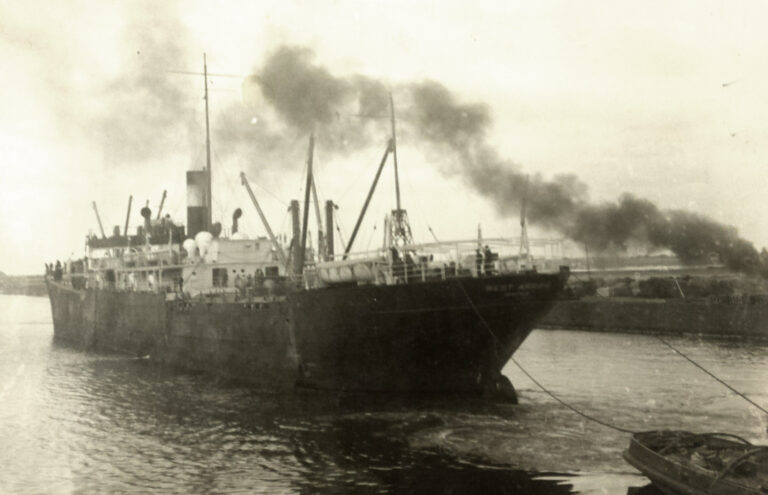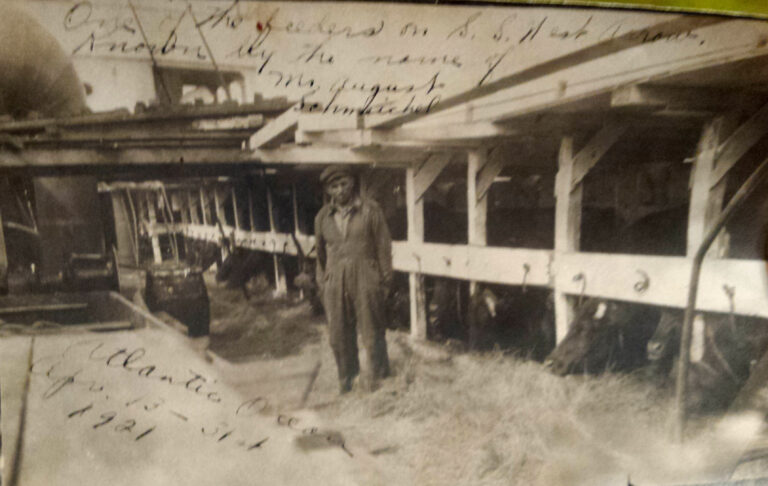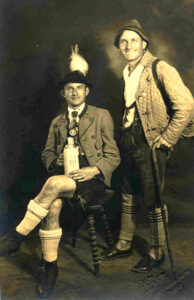In 1921 (Hutchinson County) the Battle of the Cows was waged over a herd of 700 milk cows bound for Germany.
South Dakotans of German descent became concerned of hardships suffered by the German people after World War I. A milk shortage was caused by the disruption of the German economy following the war. On December 19, 1920, news from Berlin reported the loss of the 800,000 milk cows that the Germans were forced to deliver to the Allies under terms of the Versailles Treaty.
Sentiments were high in South Dakota and across the nation, and many German-Americans wanted to help their friends and relatives living in Germany. They received permission needed from federal authorities to ship dairy cattle to Germany.
Controversy raged over whether or not Americans should be helping the Germans.
South Dakota communities announced plans to help feed the Germans, while some Americans questioned the patriotism of the plan. Three shiploads of milk cows were sent to Germany from various parts of the U.S. According to the Freeman Courier of Sept. 15, 1976, “It is not clear exactly where the first shipment originated. The second consignment of cows, totaling 732, was apparently gathered as donations from German-American farmers in Kansas, Texas and Indiana. The third and final shipment came primarily from Hutchinson County in South Dakota.”
The American Dairy Cattle Company asked Pastor Heinrich Friedrich Wildhelm Gerike, who was in charge of the Tripp congregation to supervise the work.
Another leader was Pastor Richard Tauber of the American Lutheran Church in Tripp. Local banks assisted with the collection to cover shipping costs and to support those who would accompany the livestock. Two bankers especially associated with the project were Oscar Brosz of Tripp and Reinhold Dewald of Freeman.
Since the cows had to be fed and milked, local youth were sent along on the journey. Volunteers from South Dakota were Herbert Bender, Theodore Weidenbach and Herbert Hintz (Scotland), William and Reinhold Dewald, Hugo Haar, Christ and Hans Kauffmann, Joe Wallmann and William Wipf (Freeman), W.E. Friedrichs (Alexandria), Hans Gottsche and Joseph A. Gross (Carpenter), Richard Isaak (Parkston), Albert Koehn (Corsica), William Mundt and Joseph Wipf (Bridgewater), John Sattler and Harold Serr (Tyndall), Jacob Schaefer (Armour), August Schmichel (Marion), William E. Voight (Avon), William Warnicke (Paullina), Henry Wettrock (Canistota), and Daniel Winter (Delmont). Original plans called for one shipment of cows by train from Scotland. At least 300 cows were held over the night of March 23, 1921. The remainder of the 700 cows in the total shipment were detained at Tripp along the Chicago, Milwaukee, St. Paul and Pacific Railroad line.
The Tripp Ledger commented on March 17, ” … shipment from Tripp will be made Wednesday, March 23. Cows should, if possible, be in Tripp the day before … about 300 cows are expected to be shipped from here and about 400 from Scotland. Besides the donation of these cows, $16,000 in money has been collected.”
On Wednesday, March 23, the 386 cows in Scotland and the 270 head in Tripp were being herded when Pastor H.F.W. Gerike was notified that trouble might be expected at Scotland. Some non-Germans had sworn that no cows would be sent to Germany and had recruited a gang. They threatened to march against the cows in order to stampede the herd and make shipment impossible.
In the meantime, F.F. Matenaers of the American Dairy Cattle Company had arrived in Scotland. Pastor Gerike led him to the mayor of Scotland to request that the sheriff send deputies to protect the herd of cows.
The mayor agreed with Pastor Gerike and promised to find deputies due to the threats made against the herd. Unfortunately, the mayor didn’t follow through with his promise and when Thursday came neither he or the sheriff were anywhere to be found.
Wednesday night, some 25 automobiles packed with men, and 30 more men on horseback, arrived at the scene and opened fire on the herd. Only four unarmed, young men were on duty to guard the cattle. Several cows were killed and wounded, mostly from being hit by cars. Most of the herd was scattered.
To round up the herd after Wednesday night’s raid, volunteers were called from the area. By Thursday afternoon, the results were two dead, one lame and 26 missing.
After the cows had been returned to the corral in Scotland, they were driven across the county line into Hutchinson County. There they were corralled on a farm one-half mile west of Kaylor. At the time, the farm was owned by August Link. Once the cows arrived within his territory, Karl Schmidt, sheriff of Hutchinson County, assumed responsibility for the safety of the herd.
Schmidt deputized Lieutenant Ewald Gall of Menno and put him in charge of a large posse of 200-300 farmers to protect the cows from further attack.
On the night of March 24, farmers stood guard around the 330 cows, which had been corralled in a bowl-like pasture south of the Kaylor-Tripp road. Some men hid in the cemetery across the street, using the tombstones for barricades. At about 10:30 p.m., approximately 30 cars approached, coming north from Scotland. Earlier in the evening, an unidentified call had reportedly been made to a local undertaker. The caller advised him to send an ambulance to the scene because there “soon would be a number of dead.”
When the cars reached the Freitag farm, they were unexpectedly met by Sheriff Schmidt and Lieutenant Gall, who warned them that the first man to cross the fences would be fired upon by at least 200 farmers.
According to the Scotland Journal of March 31, 1921, the attackers were again members of the American Legion. “A large number of Legionnaires from the various posts near Scotland started for Kaylor … On arriving at what was to be fighting ground, the Legionnaires found that they were outnumbered four to one in both men and guns and decided to call off the action.”
Since more trouble was anticipated the following night, when the cows were to be driven to Tripp for loading on the train, the guard was again used.
14 men were arrested and that all of them were implicated in the stampeding of the 300 head of cattle occurring in Scotland on Wednesday. After being taken into custody in Tripp, the 14 were searched. Four men were charged with carrying concealed weapons and were fined $5 and costs. All of the men were released.
On Saturday, approximately 700 cows were loaded aboard 26 rail cars en route to Sioux City. The shipment continued on to Chicago, and finally Baltimore.
The train made it with success to Baltimore. Upon its arrival, the American Legion made one last formal protest while the cows were loaded on board the West Arrow and headed for Germany.
The cattle were put in stalls with their tail end against the outside walls. The milkers had to crawl through the mess the cows left in order to get to the teats.
Reinhold Dewald later expressed his feelings about the trip to Europe. “As you know, the cattle were finally loaded. Practically all of us had pistols in our pockets to hold the howling wolves of Scotland bay. We were glad when the train finally got under way, even if we were threatened with reprisal if this should happen. On the freight train things did not go smoothly, especially with the meals. The noon meal often wasn’t served until 3 o’clock and supper in the morning.
“In Baltimore we, together with the cattle, were locked into the stockyards. The place actually thought of itself as a hotel … Yes, it even had ‘HOTEL’ printed across the top in large letters, but it still resembled a barn more than anything else. And the chickens … They certainly weren’t fried according to mother’s recipe … only one got sick and two departed for the dear hereafter.
“It has been stated that when you’re on the ocean, everything goes well as long as your stomach functions properly. Some of the men experienced this malfunction the first day of their voyage on the West Arrow. The ship was a freighter, not designed to accommodate either man or beast.
“On April 13, the ship finally set sail … after laying around Baltimore for nine days, we were glad to be on the move again. The beds had been very hard, otherwise we might have been content to lay around there till now.
“The weather was beautiful except for those who couldn’t hold up their heads anymore … Then one day and one night there blew a mighty storm. Waves washed over the ship and shook it so hard that some of the boys were thrown from their bunks.
“Before evening, winds and waves abated … Joy turned to despair when a heavy fog embraced the ship and everything else in the vicinity. The steamer’s horn shrieked so boisterously … that even the most dedicated church sleeper was kept awake and alert the whole night through.
“After 18 days we finally arrived in Germany. In Bremenhafen we had to wait till the tide rose and then we slowly proceeded up the Wesser River through locks where Germans on both sides greeted us. We greeted them with milk, of which we had a goodly supply on hand.”
No doubt, some of Germany’s dairy herd today has the bloodlines of the Holstein cows that came from Hutchinson County in 1921.

